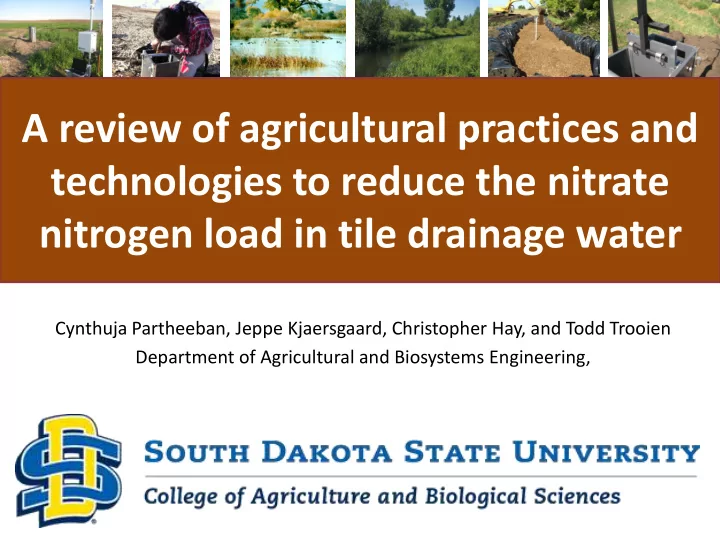

A review of agricultural practices and technologies to reduce the nitrate nitrogen load in tile drainage water Cynthuja Partheeban, Jeppe Kjaersgaard, Christopher Hay, and Todd Trooien Department of Agricultural and Biosystems Engineering,
Outline • Introduction • Agricultural practices to reduce nitrogen load in tile drain water – Improved nitrogen management – Crop rotation, cover cropping, and tillage – Controlled drainage systems – Constructed wetlands – Riparian buffers – Denitrifying bioreactors • Summary
Introduction 3
Introduction • Nitrate-nitrogen causes eutrophication in aquatic ecosystems, health hazard • Critical need to develop practices to treat tile drain water 4 Source: Wikipedia.com
Improved nitrogen management • Timing of N application at appropriate rate • Changing the timing of pre-plant single application of N from fall to spring – annual nitrate-N losses 36% reduction (Randall and Vetsch, 2002) • Application of recommended rate • Nitrification inhibitors • Help slowdown the conversion of ammonia to the more leachable nitrate by limiting the activity and population of Nitrosomonas bacteria(Stehouwer and Johnson, 1989) 5
Crop rotation, cover cropping • Crop rotation • Nitrate-N concentration in shallow groundwater: 23mg/l under continuous corn 14mg/l under corn-soybean rotation (Kanwar, 2006) • Extra N fertilizer needed for continuous corn cropping 14-36% higher nitrate-N found in subsurface drainage compared to rotating cropping system (Helmers et al., 2012) 6
Crop rotation, cover cropping • Cover cropping • Reduce subsurface drainage discharge • 11% discharge reduced compared to no cover crop • Reduce nitrate-N loss in subsurface drainage • 13 % nitrate – N loss reduced compared to no cover crop (Strock et al., 2004) A field of collards with cover crops: mix of rye, hairy vetch, and crimson clover (McGee, 2012) 7
Controlled drainage systems Illustration of regulation of water table level by controlled structure, Source: Purdue University • The outlet elevation is raised or lowered • Reduction in drain outflow – less nitrate-N loss • A 61% nitrate-N load reduction on average annually by controlled drainage (Cooke and Verma, 2012). • An average load reduction range from 18% to over 75 % depending on the drainage system design, location, soil, and site conditions (Skaggs et al 2012) 8
Constructed wetlands Schematic of wetland • Reduction of nitrates to gaseous N 2 or N 2 O through the denitrification process • 23-35% nitrate removal by wetlands (Karpuzeu, 2012;Kovacic et al.2000) • Possible limitations: Additional land required Low removal compared to bioreactor 9
Riparian buffers Saturated buffer – field tile drainage water is routing into buffer zone, Source: Dan Jaynes, USDA ARS • Prolonged contact of drainage water with the root zone offers high nitrogen uptake by plants and an opportunity for the denitrification process to occur • Study showed nitrate-N reduction from 15 mg/l to 2 mg/l by riparian buffers (Evans et al., 1996) 10
Denitrifying Bioreactor - NO 3 N 2 Presence of N Oxides (Electron acceptors) Denitrifying Bacteria pH and temperature Carbon source Suitable DO conditions (Electron donor) 11
Denitrifying woodchip bioreactor Site Reference Percent of Nitrate-N reduction removal rate Ontario, Canada (Blowes et al., 1994) >99% 10-60 L/d 0.622 g N/m 3 /d Central IA (Jaynes et al., 2008) 55 % Southern Ontario, Ca (Elgood et al., 2010) NA 0.3-2.5 mg N/L 2-22 g N /m 3 /d New Zealand (Schipper et al., 2010) NA Decatur, IL (Chun et al., 2010) 47% NA Alachua, FL (Schmidt and Clark, 2012) 65% (load reduction) NA 0.38-3.78 g N/m 3 /d Perkin IA (Christianson et al., 2012a) 22-74% 12 0.98 g N/m 3 /d Montrose, SD (Partheeban et al. 2014) 51%
Denitrifying woodchip bioreactor 13
Denitrifying woodchip bioreactor 14
Denitrifying woodchip bioreactor N 2 Average nitrate N load exit Average nitrate N load from the bioreactor enter into the bioreactor BIOREACTOR 2.8 lb/ac/year 3.5 lb/ac/year Average reduction of nitrate N load by the bioreactor 0.7 lb/ac/year (20% load reduction) 15
Cost analysis Name of the practice Cost per Kg N removal Reference (US $) Wetlands 2.91 (Hyberg, 2007; Jaynes and Isenhart, 2013) Riparian buffer 2.25 (Jaynes and Isenhart, 2013) Control drainage 1.45-2.05 (Cooke et al., 2006) management Fall planted cover crops 6.77 (Jaynes and Isenhart, 2013) Bioreactor 2.39-15.17 (Schipper et al., 2010) 8.68 (Partheeban et al., 2014) 16
Summary • Additional practice is required to treat tile drain water • Wetlands, riparian buffers – cost effective, additional land required • Controlled drainage systems – low removal rate compared to other practices • Denitrifying woodchip bioreactor – less land, cost effective, relatively high removal rate 17
Recommend
More recommend